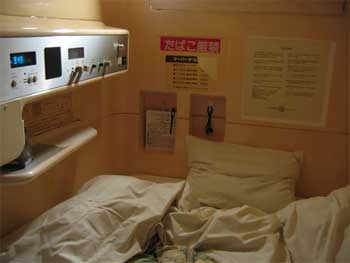
 A capsule "hotel room" in Osaka
A capsule "hotel room" in Osaka
I checked myself into the hotel on one of Osaka’s typically muggy late summer afternoons. I went to my room, which contained the standard bed, television and clock radio, and when it was time to pull the blinds, I was careful not to hit my head on the three-foot high ceiling.
I had already done that once.
So this wasn’t your average hotel room. The Sunplay at Nagahori is a capsule hotel, a must-stay for the foreign visitor to Japan who wants to know the true meaning of the term “close quarters.”
The human-sized safe deposit boxes illustrate the ingenuity of a country that is about the size of California, yet has a population roughly half that of the entire United States.
The capsule hotel’s roots stretch back to the 1970s, when architect Kisho Kurakawa came up with the idea of turning unused shipping containers into some form of lodging. The containers were modified slightly, and by the early 1980s several capsule hotels had been built, the first of which being in Tokyo’s Akasuka district. The hotels immediately became a hit by serving the sleeping needs of Japan’s burgeoning army of salarymen who were too tired to come home after doing business all day, and as is common in Japanese business circles, drinking for hours into the night.
While originally popular with businessmen, capsule hotels quickly began to appeal to people all over Japan because of their relatively low prices, with one night averaging $30 to $35. By comparison, the Imperial Hotel Osaka can cost thousands of dollars a night.
It’s rare for Japanese women to stay even at the few capsule hotels that allow them – and the one where I stayed didn’t. The prohibition was said to be a safety precaution because the blinds that pull down over the capsules’ openings didn’t lock when shut.
At the hotel in Osaka’s downtown Shinsaibashi district, the capsules are about eight feet long, a yard high and wide, and stacked two high. When you first see one of the capsule-lined hallways you think you have walked into the sleeping quarters from “Star Trek”.
Inside each plastic-walled capsule are a futon, or mattress, a mattress pad, two blankets, a pillow and a wall set with controls for lights, a radio and a small television. The capsule was very well lit and, to my surprise, didn’t induce the claustrophobia I had been warned about. Image the living room forts you and your siblings built of blankets and furniture when you were nine and you’ll get the idea.
The hotel, of course, did have bathrooms, though some were of the traditional “Japanese Style”: a two-foot-long elliptical bowl in the floor and no toilet seat to speak of, or sit on. It also had locker rooms where you could get a robe and store your valuables while bathing. Stationed at each sink was a battery of personal care products that could have put the trendiest salon to shame: hair dryers, brushes, combs, disposable razors and one-time-use toothbrushes, each with a dab of toothpaste.
Continuing my hotel exploration, I took the elevator up to the second floor where I found the theater room with 15 reclining chairs and a video screen that seemed large enough to handle an IMAX movie. I began to watch a program with about a half dozen other guests, and after about 15 minutes decided a cold beer was in order.
I found a can of ice-cold Asahi Dry beer in a vending machine. Yes, a beer vending machine. Japan has a reputation for making innovative, good quality products, and I saw many during my stay here. But I have to admit, nothing was as impressive as that machine that kicked out a half-liter can of cold Asahi.
As I continued checking out the capsule hotel, I discovered the massage room, and although the masseuse had gone home for the day, the bathing room was still open.
In Japan, bathing is a ritual, a way of cleaning one’s mind as well as body after a busy day. And for the Japanese, the bath provides many people with the only time of the day they get to themselves.
The bathing room was similar in appearance to an indoor public pool, only smaller and without a plethora of screaming kids. To the left was a series of stations, each of which had a shower sprayer for washing yourself before the bath; to the right was a rectangular tub, not much larger than a standard apartment complex pool.
As a gaijin, or “outside person,” I wasn’t used to Japanese public bathing. But despite some trepidation, I pressed on, determined to get some of the serenity that the bath was supposed to offer.
“Hot” would be a mild way of describing the water temperature, and the serenity was a bit difficult to achieve. I stuck with it for a few minutes before making my way to the exit. The two Japanese businessmen in the bathtub were amused by my attempt to join their cultural experience.
Back at my capsule, I tried out the TV built into the ceiling of the unit – and happened upon a poorly dubbed American movie. Even in one of the most Japanese forms of accommodation, where culture shock hits you the moment you walk in the door, a hint of America could be found.
photo by eightydaysjet on Flickr